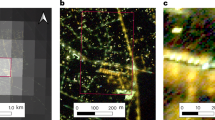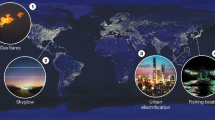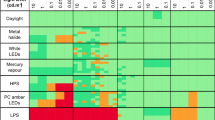Abstract
Urban planners continuously face the challenge of reducing artificial lighting to protect biodiversity while ensuring urban residents’ comfort and safety at night. Striking this balance is crucial for supporting urban residents broadly, yet it remains insufficiently explored in current research. Here we integrate remote sensing and ecological modeling to assess species’ requirements around light-pollution reduction with socioeconomic modeling to evaluate human residents’ acceptance of various street-lighting adjustments, aiming to identify the optimal lighting compromises for Montpellier, France, a midsized European city. We show that, depending on the spatial context, both tradeoffs and synergies can emerge when implementing light-pollution-mitigation measures. By integrating results into an RShiny application, we enabled urban planners to prioritize actions for each streetlight. Our findings underscore the importance of tailoring lighting policies to the specific environmental and social context rather than adopting a universal ‘one-size-fits-all’ approach.
This is a preview of subscription content, access via your institution
Access options
Subscribe to this journal
Receive 12 digital issues and online access to articles
118,99 € per year
only 9,92 € per issue
Buy this article
- Purchase on SpringerLink
- Instant access to full article PDF
Prices may be subject to local taxes which are calculated during checkout





Similar content being viewed by others
Data availability
The RShiny ‘SustainLights’ is accessible at https://sustainlight.sk8.inrae.fr/. The data associated with the RShiny app are available via Zenodo at https://zenodo.org/records/14926418 (ref. 51).
Code availability
The LightPollutionToolbox Qgis plugin is available at https://plugins.qgis.org/plugins/LightPollutionToolbox/. The Biodispersal QGIS plugin is available at https://plugins.qgis.org/plugins/BioDispersal/. The RShiny code and its contents are available at https://forgemia.inra.fr/sk8/sk8-apps/mathnum/tetis/sustainlight.
References
Falchi, F. et al. The new world atlas of artificial night sky brightness. Sci. Adv. 2, e1600377 (2016).
Kyba, C. C. M. et al. Artificially lit surface of Earth at night increasing in radiance and extent. Sci. Adv. 3, e1701528 (2017).
Sánchez de Miguel, A., Bennie, J., Rosenfeld, E., Dzurjak, S. & Gaston, K. J. First estimation of global trends in nocturnal power emissions reveals acceleration of light pollution. Remote Sens. 13, 3311 (2021).
Kyba, C. C. M., Altıntaş, Y. Ö., Walker, C. E. & Newhouse, M. Citizen scientists report global rapid reductions in the visibility of stars from 2011 to 2022. Science 379, 265–268 (2023).
Tsao, J. Y., Saunders, H. D., Creighton, J. R., Coltrin, M. E. & Simmons, J. A. Solid-state lighting: an energy-economics perspective. J. Phys. D. 43, 354001 (2010).
Kocifaj, M., Wallner, S. & Barentine, J. C. Measuring and monitoring light pollution: current approaches and challenges. Science 380, 1121–1124 (2023).
Bittel, J. Nocturnal pollinators go dark under street lamps. Nature https://doi.org/10.1038/nature.2017.22395 (2017).
Hölker, F., Wolter, C., Perkin, E. K. & Tockner, K. Light pollution as a biodiversity threat. Trends Ecol. Evol. 25, 681–682 (2010).
Hirt, M. R., Evans, D. M., Miller, C. R. & Ryser, R. Light pollution in complex ecological systems. Philos. Trans. R. Soc. B Biol. Sci. 378, 20220351 (2023).
Eisenbeis, G. in Ecological Consequences of Artificial Night Lighting (eds Rich, C. & Longcore, T.) Ch. 12 (Island, 2006).
Rydell, J., Eklöf, J. & Sánchez-Navarro, S. Age of enlightenment: long-term effects of outdoor aesthetic lights on bats in churches. R. Soc. Open Sci. 4, 161077 (2017).
Degen, J. et al. Shedding light with harmonic radar: unveiling the hidden impacts of streetlights on moth flight behavior. Proc. Natl Acad. Sci. USA 121, e2401215121 (2024).
Korpach, A. M. et al. Urbanization and artificial light at night reduce the functional connectivity of migratory aerial habitat. Ecography https://doi.org/10.1111/ecog.05581 (2022).
Laforge, A. et al. Reducing light pollution improves connectivity for bats in urban landscapes. Landsc. Ecol. 34, 793–809 (2019).
Owens, A. C. S. et al. Light pollution is a driver of insect declines. Biol. Conserv. 241, 108259 (2019).
Wang, T., Kaida, N. & Kaida, K. Effects of outdoor artificial light at night on human health and behavior: a literature review. Environ. Pollut. 323, 121321 (2023).
Cinzano, P. & Falchi, F. Toward an atlas of the number of visible stars. J. Quant. Spectrosc. Radiat. Transf. 253, 107059 (2020).
Wesołowski, M. The increase in the surface brightness of the night sky and its importance in visual astronomical observations. Sci. Rep. 13, 17091 (2023).
Stone, T. The value of darkness: a moral framework for urban nighttime lighting. Sci. Eng. Ethics 24, 607–628 (2018).
Zissis, G., Bertoldi, P. & Serrenho, T. Update on the Status of LED-Lighting World Market Since 2018. JRC Technical Report No. EUR 30500 EN (European Union, 2021).
Irwin, A. The dark side of light: how artificial lighting is harming the natural world. Nature 553, 268–270 (2018).
Bará, S., Falchi, F., Lima, R. C. & Pawley, M. Can we illuminate our cities and (still) see the stars? Int. J. Sustain. Light. 23, 58–69 (2021).
Falchi, F. & Bará, S. Light pollution is skyrocketing. Science 379, 234–235 (2023).
Lyytimäki, J. Nature’s nocturnal services: light pollution as a non-recognised challenge for ecosystem services research and management. Ecosyst. Serv. 3, e44–e48 (2013).
Mitchell, D. & Gallaway, T. Dark sky tourism: economic impacts on the Colorado Plateau Economy, USA. Tour. Rev. 74, 930–942 (2019).
Sordello, R. et al. A plea for a worldwide development of dark infrastructure for biodiversity – practical examples and ways to go forward. Landsc. Urban Plan. 219, 104332 (2022).
Beaudet, C., Tardieu, L. & David, M. Are citizens willing to accept changes in public lighting for biodiversity conservation? Ecol. Econ. 200, 107527 (2022).
Green, J., Perkins, C., Steinbach, R. & Edwards, P. Reduced street lighting at night and health: a rapid appraisal of public views in England and Wales. Health Place 34, 171–180 (2015).
Willis, K. G., Powe, N. A. & Garrod, G. D. Estimating the value of improved street lighting: a factor analytical discrete choice approach. Urban Stud. 42, 2289–2303 (2005).
Mitchell, D. M., Gallaway, T. & Olsen, R. Estimating the willingness to pay for dark skies. Int. J. Res. Eng. Technol. 6, 18–24 (2017).
Silver, D. A. & Hickey, G. M. Managing light pollution through dark sky areas: learning from the world’s first dark sky preserve. J. Environ. Plan. Manag. 63, 2627–2645 (2020).
Zielinska-Dabkowska, K. M. Healthier and environmentally responsible sustainable cities and communities. A new design framework and planning approach for urban illumination. Sustainability 14, 14525 (2022).
Bará, S. & Falchi, F. Artificial light at night: a global disruptor of the night-time environment. Philos. Trans. R. Soc. B Biol. Sci. 378, 20220352 (2023).
Bebronne, E., Heng, S. & Limbourg, S. Towards sustainable nocturnal environment management: a social-ecological-technical system analysis in Wallonia (Belgium). Discov. Environ. 2, 98 (2024).
European Commission: Directorate-General for Environment. Light Pollution – Mitigation Measures for Environmental Protection (European Union, 2023); https://data.europa.eu/doi/10.2779/906521
Dietenberger, M. et al. Reducing the fatal attraction of nocturnal insects using tailored and shielded road lights. Commun. Biol. 7, 671 (2024).
Azam, C. et al. Is part-night lighting an effective measure to limit the impacts of artificial lighting on bats? Glob. Change Biol. 21, 4333–4341 (2015).
Steinbach, R. et al. The effect of reduced street lighting on road casualties and crime in England and Wales: controlled interrupted time series analysis. J. Epidemiol. Community Health 69, 1118 (2015).
Trop, T., Shoshany Tavory, S. & Portnov, B. A. Factors affecting pedestrians’ perceptions of safety, comfort, and pleasantness induced by public space lighting: a systematic literature review. Environ. Behav. 55, 3–46 (2023).
Challéat, S. & Lapostolle, D. Getting night lighting right: taking account of nocturnal urban uses for better-lit cities. Metropolitics https://metropolitiques.eu/Getting-Night-Lighting-Right.html (2018).
Sánchez de Miguel, A. et al. Evaluating human photoreceptoral inputs from night-time lights using RGB imaging photometry. J. Imaging 5, 49 (2019).
Cheng, B. et al. Automated extraction of street lights from JL1-3B nighttime light data and assessment of their solar energy potential. IEEE J. Sel. Top. Appl. Earth Obs. Remote Sens. 13, 675–684 (2020).
Ranzoni, J., Giuliani, G., Huber, L. & Ray, N. Modelling the nocturnal ecological continuum of the state of Geneva, Switzerland, based on high-resolution nighttime imagery. Remote Sens. Appl. 16,100268 (2019).
Kalinkat, G. et al. Assessing long-term effects of artificial light at night on insects: what is missing and how to get there. Insect Conserv. Divers. 14, 260–270 (2021).
Van den Broeck, M., De Cock, R., Van Dongen, S. & Matthysen, E. Blinded by the light: artificial light lowers mate attraction success in female glow-worms (Lampyris noctiluca L.). Insects 12, 734 (2021).
Voigt, C. C. et al. The impact of light pollution on bats varies according to foraging guild and habitat context. BioScience 71, 1103–1109 (2021).
Touzot, M. et al. Artificial light at night alters the sexual behaviour and fertilisation success of the common toad. Environ. Pollut. 259, 113883 (2020).
Evens, R. et al. Skyglow relieves a crepuscular bird from visual constraints on being active. Sci. Total Environ. 20, 165760 (2023).
Watts, K. et al. Targeting and evaluating biodiversity conservation action within fragmented landscapes: an approach based on generic focal species and least-cost networks. Landsc. Ecol. 25, 1305–1318 (2010).
Beaudet, C., Tardieu, L., Crastes-dit-sourd, R. & David, M. Mapping preferences derived from a choice experiment: a comparison of two methods. Preprint at https://papers.ssrn.com/sol3/papers.cfm?abstract_id=4931486 (2024).
Beaudet, C. et al. Planning sustainable urban lighting for biodiversity and society. Zenodo https://doi.org/10.5281/zenodo.14926417 (2024).
Acknowledgements
We are grateful to our many academic colleagues for their fruitful advice and comments on early versions of the study, in particular J. Amsallem, M. Chailloux, A. Sensier, A. Besnard, R. Chakir, S. Challéat, A.-C. Vaissière, A. Pery and R. Crastes dit Sourd. We also thank M. Lenormand for his help and support on the RShiny application development and storage. We thank the naturalists at the LPO, OPIE and Groupe Chiroptère du Languedoc-Roussillon and the experts and citizens who have agreed to take part in the focus groups or the survey. We also thank the MMA elected officials (in particular B. Paternot) and municipal technical staff (in particular D. Guiraudie) whose participation in the research has made this work possible. In relation to this work, L.T., S.P., J.C. and V.D. received support from the Occitanie Region in the READYNOV Project POLLUM (grant no. 7576-24001770 TETIS).
Author information
Authors and Affiliations
Contributions
L.T. drafted most of the initial outline and core initial content of the Article, with C.B., S.P., J.C., L.M., V.D. and M.D. enriching the outline and text with further illustrations, references and clarifications. They also edited the text thoroughly. S.P. and J.C. developed the ecological study with the input of L.M. and the other authors, S.P. and V.D. developed the light-pollution indicators, and C.B, L.T. and M.D. developed the socioeconomic survey and mapping. C.B. developed the RShiny application.
Corresponding author
Ethics declarations
Competing interests
The authors declare no competing interests.
Peer review
Peer review information
Nature Cities thanks Andrew Fairbairn and the other, anonymous, reviewer(s) for their contribution to the peer review of this work.
Additional information
Publisher’s note Springer Nature remains neutral with regard to jurisdictional claims in published maps and institutional affiliations.
Supplementary information
Supplementary Information
Sections 1–3, Figs. 1 and 2 and Tables 1 and 2.
Rights and permissions
Springer Nature or its licensor (e.g. a society or other partner) holds exclusive rights to this article under a publishing agreement with the author(s) or other rightsholder(s); author self-archiving of the accepted manuscript version of this article is solely governed by the terms of such publishing agreement and applicable law.
About this article
Cite this article
Tardieu, L., Beaudet, C., Potin, S. et al. Planning sustainable urban lighting for biodiversity and society. Nat Cities 2, 518–531 (2025). https://doi.org/10.1038/s44284-025-00245-7
Received:
Accepted:
Published:
Issue Date:
DOI: https://doi.org/10.1038/s44284-025-00245-7



